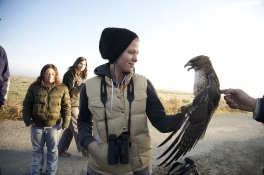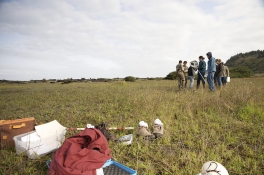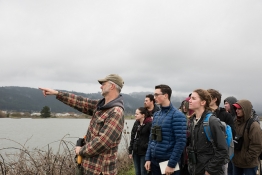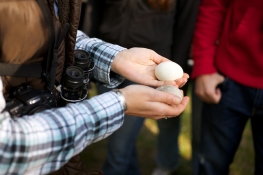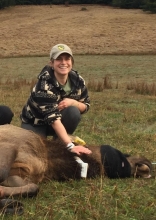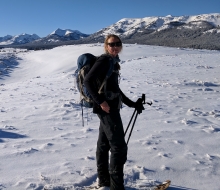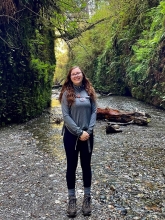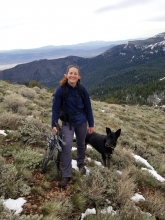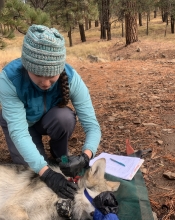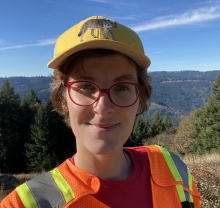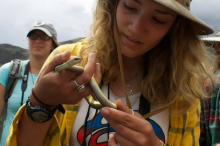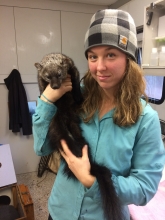Micaela Szykman Gunther
Professor
Research interests focus on the behavioral ecology of mammals. Her work is primarily based on field studies and uses naturally occurring variation in wild populations to address testable alternative evolutionary hypotheses in behavioral ecology.
Education
Courses Taught
Research
I am generally interested in the behavior of social mammals, with special interest in social carnivores. Since starting at Humboldt in 2006, my students and I have conducted field research projects on African wild dogs, North American river otters, Pacific fisher, Humboldt marten, Roosevelt elk, black-tailed deer, beavers, gray wolves, Mexican wolves, black bears, and mountain lions, among other various species observed during the course of undergraduate students’ honors projects (spotted hyenas, raccoons, cranes and other birds, bats, turtles and lizards, just to name a few).
My work is primarily based on field studies and uses naturally occurring variation in wild populations to address testable alternative evolutionary hypotheses in behavioral ecology. Much of my current work with carnivores includes the use of non-invasive methods and indirect observations such as the use of remote cameras, scat sampling, and tracking.
Recently, my graduate students have completed a variety of local projects. Several students have conducted complementary studies on North American river otters around Humboldt Bay, investigating various aspects of river otter ecology, including 1) using genetic markers to determine population number, structure and movements, 2) elucidating the relationship between stress hormone levels and water quality, 3) evaluating diet as a function of food availability, and 4) elucidating habitat selection and use. Several additional students are working on projects involving the mid-sized forest carnivores, fisher and marten. Areas of research include extent of home range overlap and den attendance in Pacific fisher, use of rest boxes and habitat selection by the federally threatened Humboldt marten, and diet of these and other carnivore species. Finally, several students have completed projects looking at Roosevelt elk population management in collaboration with partners at the California Department of Fish and Wildlife.
A Commitment to Diversity, Equity, and Inclusion
The Gunther lab is a healthy and safe environment committed to maintaining and promoting a diverse, inclusive, and collaborative work environment where members are empowered to freely and openly share their different views, ideas, and experiences. We welcome, support, and provide equal opportunities to undergraduate and graduate students from different socioeconomic backgrounds, races and ethnicities, citizenship or immigration status, gender identities and sexualities, religions, disabilities, familial obligations, and other personal identities. Our goal is to foster experiences that teach values and tools that last a lifetime and lay a strong foundation for future careers in wildlife management and conservation.
We acknowledge that the land on which we sit is Wiyot ancestral land, and much of our lives and work are conducted in the unceded territory and traditional ancestral homeland of several Indigenous nations including the Hupa, Karuk, Mattole, Tolowa, Wailaki, Wiyot, Yurok, and other original inhabitants of Humboldt County. We respect and share our gratitude to these Indigenous communities. We thank, honor, and learn from the original caretakers of this land that continues to be cherished and protected. We are grateful for our collaborations with tribal partners, including biologists from Yurok, Wiyot, Hupa, Toluwa, and the Blue Lake Rancheria current and ancestral lands who work closely with our students on various projects.
Prospective Graduate Students
If you are interested in pursuing studies generally pertaining to the behavioral ecology of (social) mammals under my supervision, you may get in touch with me via email. With your inquiry, be sure to include: 1) a cover letter including information on your long-term career goals, details of your past research (particularly field-based) experiences, and why you want to attend graduate school and join this research lab; 2) a recent cv/resume; and 3) relevant university transcripts (unofficial are fine). I may later request that you submit a 2-3 page proposal of a possible research topic that you would be interested to pursue if admitted to work with me here at Humboldt. To see the theses that have been completed by graduate students in my research lab and our Wildlife program in general, you may visit Humboldt Digital Scholar or Humboldt Digital Commons on the Humboldt website or click the thesis titles below.
To learn about the university application process for graduate studies in Wildlife visit the CNRS Graduate Studies website.
Be sure to view the graduate students' web site!
Current Graduate Students
| Name | Thesis |
|---|---|
Jordan Stevens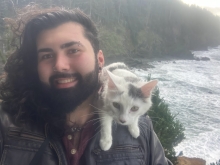 |
Jordan is surveying Humboldt marten prey species through a combination of live trapping and spot mapping, in order to assess their abundances prior to restoration in Redwood National and State Parks. He intends to explore potential correlation between prey abundances, mesocarnivore activity, and... Read Jordan's bio |
Destiny Saucedo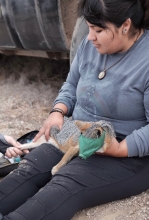 |
Destiny is investigating survival rate and causes of mortality in island fox pups on San Clemente Island. Island foxes are vulnerable to extinction due to their restricted distribution and population sizes, therefore understanding population characteristics of this vulnerable species is critical... Read Destiny's bio |
Brielle Jaglowski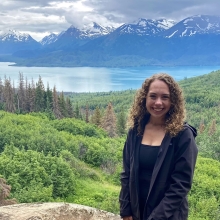 |
Brielle will be assessing the road crossing behavior of elk herds that reside along Highway 101 on the North Coast of California using data collected from GPS collars. She is working on a project designing and testing an Electronic Detection System on Highway 101 in Humboldt County to alert drivers... Read Brielle's bio |
| Jackie Killam |
Jackie is working with the Yurok Tribe to evaluate the Humboldt marten population on Yurok current and ancestral territory. |
Alyssa Roddy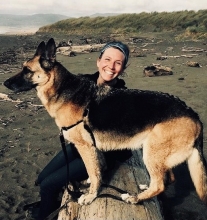 |
Examining conservation importance of slash pile management on private timberlands in northern California Alyssa will be investigating wildlife use of slash piles with a focus on Humboldt marten, Pacific fisher, and their predators. She will be using remote trail cameras and scat collection to assess carnivore occurrence and diet in the context of slash pile use. Her research is aimed at... Read Alyssa's bio |
| Breana Hernandez | Wetland biodiversity surveyed via eDNA |
Former Graduate Students
Publications
[* grad student author; ** undergraduate student author]
Henk, M.*, C. Hilson, W.T. Bean, D. Barton, and M.S. Gunther. 2022. Noninvasive genetic sampling with a spatial capture-recapture analysis to estimate abundance of Roosevelt elk. Journal of Wildlife Management. https://doi.org/10.1002/jwmg.22294.
Mohr, A.S.*, J. Ewanyk*, O. Hardy*, J. Windsor*, E. Nigon*, C. Hilson, M.S. Gunther, and W.T. Bean. 2022. A multi-metric movement model for identifying elk parturition events. Wildlife Society Bulletin 46: https://doi.org/10.1002/wsb.1256.
Moriarty, K.M., J. Thompson, M. Delheimer, B.R. Barry, M. Linnell, T. Levi, K. Hamm, D. Early, H. Gamblin*, M. Szykman Gunther, J. Ellison, J. Prevéy, J. Harman, and R. Davis. 2021. Predicted distribution of a rare and understudied forest carnivore: Humboldt martens (Martes caurina humboldtensis). PeerJ 9:e11670 http://doi.org/10.7717/peerj.11670.
Cosby, H.* and M.S. Gunther. 2021. Variation in diet and activity of river otters (Lontra canadensis) by season and aquatic community. Journal of Mammalogy. https://doi-org.ezproxy.humboldt.edu/10.1093/jmammal/gyaa165.
- Soller, J**., D.E. Ausband, and M. Szykman Gunther. 2020. The curse of observer experience: Error in noninvasive genetic sampling. PLoS ONE 15(3):e0229762.
- Guerrero-Casado, J., R. Cedeño, J. Johnston**, M.S. Gunther. 2020. New records of the critically endangered Ecuadorian white-fronted capuchin (Cebus aequatorialis) detected by camera traps. Primates 61(2) DOI: 10.1007/s10329-019-00787-0.
- Sprowles, A.E., K. Goldenberg, P.D. Goley, S. Ladwig, F. Shaugnessy, K.J. Malloy, C.R. Baldy, M.M. Mola, J.R. Smith, M.A. Hemphill-Haley, M.J. Michalak, C.P. Till, A.P. O'Dowd, G. Black, P.L. Siering, E. Cashman, A.M.F. Tomescu, M.P. Hurst, B. Mazzag, S. Manor, D.R. Oliver, J.R. Dunk, J. Abel, M.S. Gunther, A. Buchheister, R. Saunders, J. Floss, E. Sullivan, S. Ben-Zvi, and M.D. Johnson. 2019. Place Based Learning Communities on a Rural Campus: Turning Challenges into Assets. Learning Communities Research and Practice 7(1):Article 6.
- Marneweck C, G. Beverley, H.T. Davies-Mostert, C. du Plessis, K. Forsmann, M. Gusset, C. Kelly, H. Kilian, A.F.J. Marchal, D.G. Marneweck, K. Marnewick, C. Owen, G. Postiglione, R. Slotow, M. Somers, M. Szykman Gunther, B. Whittington-Jones, D.M. Parker. 2019. Factors affecting the success of artificial pack formation in an endangered, social carnivore: the African wild dog. Animal Conservation 22:493-502.
- Delheimer, M*., K. Slauson, M.S. Gunther, and W. Zielinski. 2018. Use of artificial cavities by Humboldt marten. Wildlife Society Bulletin 42: 510-517. DOI 10.1002/wsb.900.
- Allen, M.L., M.S. Gunther, and C.C. Wilmers. 2017. The scent of your enemy is my friend? The acquisition of large carnivore scent by a smaller carnivore. Journal of Ethology 35:13-19.
- Somers, M.J., P. Becker*, D.J. Druce, J. Graf*, M. Szykman Gunther, D. Marneweck, M. Trinkel, M Moleón, and M.W. Hayward. Reassembly of the large predator guild into Hluhluwe-iMfolozi Park. 2017. In Conserving Africa’s mega-diversity in the Anthropocene: the Hluhluwe-iMfolozi Park story. J.P.G.M. Cromisgt, S. Archibald and N. Owen-Smith, eds. Cambridge University Press.
- Campana, M.G., L.D. Parker, M.T. R. Hawkins, H.S. Young, K.M. Helgen, M. Szykman Gunther, R. Woodroffe, J.E. Maldonado, and R.C. Fleischer. 2016. Genome sequence, population history, and pelage genetics of the endangered African wild dog (Lycaon pictus). Genome Biology 17:1013.
- Jennings, E.**, and M.S. Gunther. 2016. Effects of high temperatures and sun exposure on Sherman trap internal temperatures. Northwest Science 89:414-419.
- Allen, M.L., B.E. Evans, and M.S. Gunther. 2015. A potential range expansion of the coastal fisher (Pekania pennanti) population in California. California Fish and Game 101:280-285.
- Taylor, A.P.**, M.L Allen, and M.S. Gunther. 2015. Black bear marking behaviour at rub trees during the breeding season in northern California. Behaviour 152:1-15.
- Slauson, K., M. Delheimer*, B. Zielinski, M.S. Gunther. 2015. The effect of restoring cavity structures on mammals in young post-logging forests of the redwood region. Report submitted to Save the Redwoods League.
- Szykman Gunther, M. and C. Cummins*. 2015. Den-attendance of fishers (Pekania pennanti) and potential impacts of timber harvest on fisher den ecology. Report submitted to the Oregon Zoo Foundation.
- McCoy, R.H., S.L. Murphie*, M. Szykman Gunther, and B.I. Murphie. 2014. Influence of hair loss syndrome on black-tailed deer fawn survival. Journal of Wildlife Management 78:1177-1188.
- Darnell, A.M.*, J.A. Graf*, M.J. Somers, R. Slotow and M. Szykman Gunther. 2014. Space use of African wild dogs in relation to other sympatric large carnivores. PLoS ONE 9(6): e98846.
- Brzeski, K.*, M.S. Gunther, and J.M. Black. 2013. Estimating river otter abundance using non-invasive genetic methods and evaluating citizen science monitoring. Journal of Wildlife Management 77:1523–1531.
- Flacke, G.*, P. Becker*, D. Cooper, M. Szykman Gunther, I. Robertson, C. Holyoake, R. Donaldson and K. Warren. 2013. An infectious disease and mortality survey in a population of free-ranging African wild dogs and sympatric domestic dogs. In press at International Journal of Biodiversity.
- Becker, P.A.*, P. Miller, M. Szykman Gunther, M.J. Somers, D.E. Wildt, and J.E. Maldonado. 2012. Inbreeding avoidance influences the viability of reintroduced populations of African wild dogs (Lycaon pictus). PLoS ONE 7(5): e37181.
- Prager, K.C., J.A.L. Mazet, L. Munson, S. Cleaveland, C.A. Donnelly, E.J. Dubovi, M. Szykman Gunther, R. Lines, G. Mills, H.T. Davies-Mostert, J.W. McNutt, G. Rasmussen, K. Terio, R. Woodroffe. 2012. The effect of protected areas on pathogen exposure in endangered African wild dog (Lycaon pictus) populations. Biological Conservation 160:15-22.
- Szykman Gunther, M. 2012. Using non-invasive tools to evaluate success of African wild dog reintroductions. In Proceedings from the Painted Dog Workshop, April 2011. Pittsburgh Zoo and PPG Aquarium, Pittsburgh.
- Spiering, P.*, M. Szykman Gunther, M.J. Somers, D.E. Wildt, M. Walters, A.S. Wilson and J.E. Maldonado. 2011. Inbreeding, heterozygosity and fitness in a reintroduced population of endangered African wild dogs (Lycaon pictus). Conservation Genetics 12:401-412.
- Szykman Gunther, M. 2011. Genetic variation and the reintroduction of African wild dogs in South Africa. American Zoo and Aquarium Association Connect magazine October issue, p.34.
- Spiering, P.*, M.J. Somers, J.E. Maldonado, D.E. Wildt, and M. Szykman Gunther. 2010. Reproductive sharing and proximate factors mediating cooperative breeding in the African wild dog (Lycaon pictus). Behavioral Ecology and Sociobiology 64:583-592.
- Flacke, G.*, P. Spiering*, D. Cooper, M. Szykman Gunther, I. Robertson, C. Palmer, and K. Warren. 2010. A survey of internal parasites in free-ranging African wild dogs (Lycaon pictus) from KwaZulu-Natal, South Africa. South African Journal of Wildlife Research 40:176-180.
- Spiering, P.*, M. Szykman Gunther, D.E. Wildt, M.J. Somers and J.E. Maldonado. 2009. Sampling error in non-invasive genetic analyses of an endangered social carnivore. Conservation Genetics 10:2005-2007.
- Comizzoli, P., A. Crosier, N. Songsasen, M. Szykman Gunther, J. Howard and D.E. Wildt. 2009. Advances in reproductive science for wild carnivore conservation. 2009. Reproduction in Domestic Animals. 44(s2):47-52.
- Somers, M.J., J.A. Graf, M. Szykman, R. Slotow and M. Gusset. 2008. Dynamics of a small re-introduced population of endangered wild dogs over 25 years: Allee effects and the implications of sociality for conservation. Oecologia 158:239-247.
- Gusset, M., A.H. Maddock, M. Szykman, M. Walters, B. Mthembu, G.J. Gunther, M.J. Somers. 2008. Conflicting Human Interests over the Re-Introduction of African Wild Dogs (Lycaon pictus) into Hluhluwe-iMfolozi Park, South Africa. Biodiversity and Conservation 17:83-101.
- Gusset, M., S.J. Ryan, M. Hofmeyr, G. van Dyk, H.T. Davies-Mostert, J.A. Graf, C. Owen, M. Szykman, D. Macdonald, S.L. Monfort, D.E. Wildt, A. Maddock, R. Slotow, M.G.L. Mills, and M.J. Somers. 2008. Efforts going to the dogs? Evaluating attempts to re-introduce endangered wild dogs in South Africa. Journal of Applied Ecology 45:100-108.
- Trinkel, M. N. Ferguson, T. Burke, A. Reid, Ca. Reid, Cr. Reid, P. Haveman, D. Robertson, M. Somers, L. Turelli, J. Graf, M. Szykman, D. Cooper, D. Balfour, P. Hartley, G. van Dyk, C. Packer and R. Slotow. 2008. Translocating lions into an inbred lion population in the Hluhluwe-iMfolozi Park, South Africa. Animal Conservation 11:138-43.
- Szykman, M. R.C. Van Horn, A.L. Engh, E.E. Boydston, and K.E. Holekamp. 2007. Courtship and mating in free-living spotted hyenas, Crocuta crocuta. Behaviour 144:815-846.
- Woodroffe, R., H. Davies-Mostert, J.R. Ginsberg, J.A. Graf, K. Leigh, K. McCreery, M.G.L. Mills, A. Pole, G.S.A. Rasmussen, R. Robbins, M.J. Somers and M. Szykman. 2007. Rates and causes of mortality in endangered African wild dogs (Lycaon pictus): Lessons for management and monitoring. Oryx 41:215-223.
- Saleni, P., M. Gusset, J.A. Graf, M. Szykman, M. Walters and M.J. Somers. 2007. Refuges in time: temporal avoidance of interference competition in endangered wild dogs. Canid News 10.2.
- Szykman, M. 2006. African wild dog reintroduction and conservation in South Africa. Communiqué of the American Zoo and Aquarium Association January issue, pp.21-22.
- Szykman, M. 2006. Painted wolves return to Zululand. Zoogoer 35(2):16-23.
- Somers, M.J., J.A. Graf*, M. Szykman, R. Slotow and M. Gusset. Dynamics of a small re-introduced population of endangered wild dogs over 25 years: Allee effects and the implications of sociality for conservation. In review at Oecologia.
- Graf, J.A.*, M.J. Somers, M. Szykman, and R. Slotow. Heterogeneity in the density and distribution of spotted hyaenas in Hluhluwe-iMfolozi Park, South Africa. In review at Austral Ecology.
- Woodroffe, R., J.M. André, B. Andulege, F. Bercovitch, A.A. Carlson, P.B. Coppolillo, H. Davies-Mostert, A.J. Dickman, P. Fletcher, J.R. Ginsberg, M. Hofmeyr, M.K. Laurenson, K. Leigh, P.A. Lindsey, R. Lines, J.K. Mazet, K. McCreery, J.W. McNutt, M.G.L. Mills, M. Msuha, L. Munson, M.N. Parker, A. Pole, G.S.A. Rasmussen, R. Robbins, C. Sillero-Zubiri, M.J. Swarner, & M. Szykman. 2005. Tools for conservation of the African wild dog: Do we know enough? What more do we need to know? Wildlife Conservation Society/IUCN Canid Specialist Group, New York/Oxford.
- Szykman, M., A.L. Engh, R.C. Van Horn, E.E. Boydston, K.T. Scribner, and K.E. Holekamp. 2003. Rare male aggression directed toward females in a female-dominated society: Baiting behavior in the spotted hyena. Aggressive Behavior 29:457-474.
- Boydston, E.E., K.M. Kapheim, M. Szykman, and K.E. Holekamp. 2003. Individual variation in space use by female spotted hyenas. Journal of Mammalogy 84:1006-1018.
- Boydston, E.E., K.M. Kapheim, H.E. Watts, M. Szykman, and K.E. Holekamp. 2003. Altered behavior in the spotted hyena associated with increased human activity. Animal Conservation 6:207-219.
- Engh, A.L., S.M. Funk, R.C. VanHorn, K.T. Scribner, M.W. Bruford, S. Libants, M. Szykman, L. Smale, K.E. Holekamp. 2002. Reproductive skew among males in a female dominated mammalian society. Behavioral Ecology 13:193-200.
- Szykman, M., A.L. Engh, K.T. Scibner, R.C Van Horn, S.M Funk, and K.E. Holekamp. 2001. Association patterns among male and female spotted hyenas (Crocuta crocuta) reflect male mate choice. Behavioral Ecology and Sociobiology 50:231-238.
- Holekamp, K.E., M. Szykman, E.E. Boydston, and L. Smale. 1999. Association of seasonal reproductive patterns with changing food availability in an equatorial carnivore, the spotted hyena (Crocuta crocuta). Journal of Reproduction and Fertility 116:87-93.
- Holekamp, K.E., E.E. Boydston, M. Szykman, I. Graham, K.J. Nutt, S. Birch, A. Piskiel, and M. Singh. 1999. Vocal recognition in the spotted hyaena and its possible implications regarding the evolution of intelligence. Animal Behaviour 58:383-395.
- Holekamp, K.E., L. Smale, and M. Szykman. 1996. Rank and reproduction in the female spotted hyaena. Journal of Reproduction and Fertility 108:229-237.

